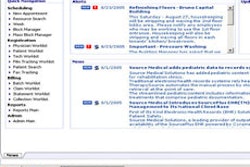Quality improvement (QI) methods have had a profound impact on how healthcare organizations manage patient care delivery systems. For more than a decade, QI methodologies have led to improvements in daily workflow and decision-making, such as medication management, disease management, patient throughput, and wait times. Perhaps more important, the focus on QI has made a significant impact on the number of patient lives saved and year-over-year improvements in U.S. healthcare.
QI process changes impact patient care delivery as well as the multiple systems that exist behind the scenes. However, the growth in QI methodologies has not recognized the importance of integrating information technology solutions as the way to enhance patient care.
Information technology in the QI cycle: The current landscape
When QI was first introduced to the healthcare industry, hospitals were just beginning to implement technology advancements that are more common today, such as e-mail systems and robust electronic health records (EHRs). This has changed immensely over the past decade with the evolution of digital technology and the significant information technology (IT) investments made by many healthcare organizations deploying digital solutions, such as PACS, computer-based physician order entry (CPOE), and modules of the EHR, to provide safer, more efficient patient care diagnoses. Parallel to these developments, has been the deployment of countless QI projects that have led to improvements in clinical and business practices.
However, despite progress that has been made in QI and IT adoption, these areas still remain separate from one another, primarily because healthcare technology purchasing decisions are often made by independent clinical departments as a result of clinical preferences and budget controls. Given all the QI and IT advances that have been made, many patients today are still unaware of, or have limited to no access to, their medication history and lab results. Disconnected islands of patient information exist in multiple settings, including hospital departments, clinics, physician offices, imaging centers, and pharmacies.
QI methodologies bring tremendous benefits, yet they beg the following questions:
- How is IT incorporated into these methods?
- What was the technology supporting these projects?
- If more technology were part of these solutions, would additional outcomes have been recognized?
Combining QI and technology can advance improvements at a faster rate of return for healthcare organizations, and for patients and their families.
Recent IT advances have changed the way healthcare information is managed, shared, and protected. An intelligent information infrastructure allows healthcare organizations to manage all clinical and business applications and the networks that manage information throughout a healthcare delivery continuum. An information life cycle management (ILM) approach is needed to truly accelerate patient care quality and the digital transformation in this country.
Combining ILM strategies and QI
Healthcare professionals often view IT as only the desktop computers that allow the viewing of patient information and basic digital images. As IT advances, we have underestimated the value of an infrastructure and network that delivers information to the point of care when and where patient information is needed. Having an ILM approach to the IT infrastructure provides much more benefit than desktop technology alone.
ILM is all about having an IT strategy that enables healthcare organizations to get the most value possible from its information, for the lowest cost, at every point in the life cycle of a patient's care. This requires an intelligent information infrastructure that captures, stores, manages, protects, secures, moves, and archives patient digital information -- and does this efficiently and effectively, with built-in intelligence and automated policies that trigger the right information management action.
An ILM approach combined with QI optimizes the healthcare industry by managing information flow and process from large individual applications such as EHR, PACS, CPOE, e-mail, and databases creating a unified approach to extracting, archiving, and accessing information.
The future position and direction of healthcare systems is bright and full of opportunity. As organizations move forward in digitizing images and health records, instantly sharing patient information for clinicians will become far easier, speeding diagnosis and improving treatment. Digital transformation will also sharpen the health system's responsiveness to outbreaks in disease and facilitate evidence-based medicine.
ILM allows for a seamless flow of electronic information that runs from genomic research, drug discovery, clinical trials, and pharmacogenomics, all the way to the EHR. This is the way to speed drug discovery, reduce diagnostic errors, increase operating efficiencies, and, above all, boost the quality of healthcare. However, this cannot be achieved without the combined expertise of clinical QI methodologies and the proper deployment of an intelligent information infrastructure.
Call to action: Integrate ILM into QI
ILM enables the capability to connect clinical applications with a broad range of information requirements, through the deployment of an intelligent information infrastructure, while maintaining the confidentiality, integrity, and availability of the patient record. To meet the growth and demands of emerging healthcare applications, QI is needed for deployment of solutions that meet the needs of physicians and patients, in a safe, reliable, and efficient operation.
QI leadership needs to embrace current IT advances, and use them to further drive and raise the bar to facilitate clinical outcomes. As positive outcomes are further achieved, professionals need to realize that growing, networked healthcare systems will have no boundaries. That said, the direction of hospital and healthcare systems will continue to support QI's growth in driving the quality of patient care.
Healthcare professionals also need to further rely on technology and use new technology methodologies to create consistent reviews of quality and care. In addition, they need to critically assess how community-based hospitals successfully link IT information infrastructures to clinical applications, which can result in positive outcomes impacting patient care, finances, and operations. Through QI practice, we need to further demonstrate recommendations on the basis of lessons learned.
Today's IT advances impact healthcare in three distinct areas:
First, clinical advances are made when caregivers gain immediate access to a unified patient view across the enterprise by eliminating stove-piped departmental based operations. High availability of patient information accelerates the speed of safer patient care decision-making and increases staff satisfaction.
Second, operational advances are achieved when access and retrieval of information is increased through network architecture design, increasing patient information access, integrity, and protection while minimizing human resource requirements. Improved network access enables medical staffs that are geographically dispersed to coordinate and collaborate easily.
Finally, financial impacts can be realized by the consolidation of storage and servers across clinical departments.
Applying QI methodologies with IT solutions is a critical part of the healthcare improvement cycle and enhanced outcomes of patient care delivery models. By combining QI methodologies with an intelligent ILM strategy, healthcare professionals will be able to further deliver quality-driven, efficient clinical practice in our healthcare systems and provide the highest level of service to patients.
By Jonathan Mello
AuntMinnie.com contributing writer
November 2, 2006
Jonathan Mello is director of global healthcare solutions for Hopkinton, MA-based EMC. He has held hospital administrative appointments at Boston Harvard Teaching Hospitals, and has spoken and published on the subject of improving healthcare quality and increasing operational efficiencies in the U.S. and overseas. He is also a member of the College of Healthcare Information Management Executives (CHIME) Foundation board and board of trustees.
Related Reading
Choose image archiving solutions before data volume grows too large, January 1, 2006
Digital library can ease transition to digital mammo, October 26, 2005
Analog workflow analysis guides RIS/PACS implementation, September 16, 2005
Information lifecycle management: A prescription for the healthcare industry, December 31, 2004
Digital archiving ubiquitous in U.S. cath labs, September 7, 2004
Copyright © 2006 EMC



















